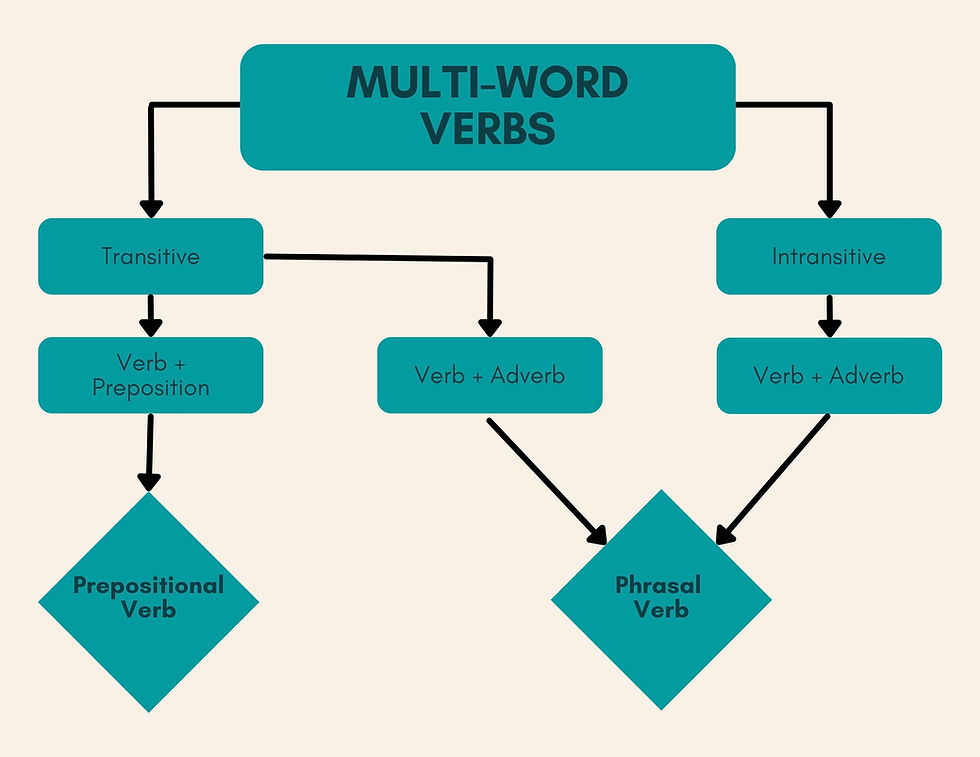Not all 'phrasal verbs' are phrasal verbs
- Catherine Jones

- Jun 26
- 4 min read
Updated: Aug 6
Hi reader! What brings you to my blog? It's probably because you find phrasal verbs confusing and you want to understand them better. Even if you are an advanced speaker of English (or a teacher of English), it's likely that you'll find this area problematic. It's a complex area, but today we aim to find a bit more clarity than we had yesterday, and tomorrow we'll try to get a bit more.
Want to know a secret?
Part of the reason for the confusion is that not all 'phrasal verbs' are actually phrasal verbs. Lots of textbooks and online resources call them all phrasal verbs, but they aren't. They are multi-word verbs. A multi-word verb is a verb and another particle which together create a new meaning.
verb + particle(s) = new meaning
Here are two examples:
She looked after her younger brother.
She turned down the job offer.
One of these examples is a phrasal verb and one is a prepositional verb. They are both multi-word verbs.
How English works
English uses a small number of high-frequency verbs and particles in various combinations to create a large number of very useful meanings. They are not always easy to translate directly, but they are very natural and important in everyday English.
Multi-word verbs
When a verb and particle combination has a new meaning, we call it a multi-word verb, but there are two types:
Prepositional verbs
Phrasal verb (true phrasal verbs)

Just to let you know...My method of teaching aims to cut through all the confusion about phrasal verbs and prepositional verbs. It helps you find clarity and achieve a breakthrough in your understanding. If you want to learn more or focus on specific topics like this, feel free to get in touch.
Prepositional verb or phrasal verb?
The first thing we need to understand is whether the multi-word verb is transitive or intransitive.
A transitive verb [t] is a verb which requires an object.
She turned down the job offer.
An intransitive verb [i] is a verb which doesn't require an object.
The car broke down.
and if you're not clear on what an object is, here's a quick reminder:
The subject is the noun/noun phrase/pronoun doing the verb.
Catherine turned down the offer.
The object is the noun/noun phrase/pronoun affected by the verb.
Catherine turned down the offer.
The next thing we need to understand is the role of a preposition.
A preposition goes before a noun to connect it to the rest of the sentence.
Catherine ate an ice cream on the beach.
She applied for a new job.
Since a preposition is always followed by a noun, the particle in an intransitive multi-word verb must be an adverb.
The plane took off.
The car broke down.

Now, we have to deal with those which are transitive.
You've probably come across the concept of 'separable' or 'inseparable' multi-word verbs (remembering that most textbooks wrongly call all of them 'phrasal verbs'). This is where we need to understand the function of the particle.
We know that a preposition is followed by a noun, so prepositional verbs are inseparable - the noun must come after it.
An adverb can either go before the noun (the object) or after it so transitive phrasal verbs are separable.
Intransitive phrasal verbs don't have an object so there is no question of separability.

More examples of multi-word verbs:
(Transitive) prepositional verb
She listened to the Beatles.
Transitive phrasal verb
She turned off the light / She turned the light off.
Intransitive phrasal verb
The plane took off.
Why does this matter?
Knowing the difference helps you use multi-word verbs correctly in sentences:
Understand whether you can separate the verb and particle or not.
She looked after her sister. ✔ CORRECT
She looked her sister after. X INCORRECT
She turned down the proposal. ✔ CORRECT
She turned the proposal down. ✔ CORRECT
Use pronouns correctly with these verbs to avoid common mistakes.
She listened to it. ✔ CORRECT
She turned off it. x INCORRECT
She turned it off. ✔ CORRECT
A useful tip
Dictionaries often show true phrasal verbs as separable by placing the object in italics between the verb and particle. This signals that the verb and particle can be separated.
to turn something off
For prepositional verbs, dictionaries show the object after the preposition, indicating the inseparable structure.
to listen to something
So, what next?
Check your textbooks and resources. Are they all called phrasal verbs? Should they be? Many textbooks and resources call both phrasal and prepositional verbs simply 'phrasal verbs.' This can be confusing and make learners feel overwhelmed. Getting the terminology right and understanding the difference helps you take control and use these verbs confidently.
Remember, phrasal verbs are always separable, and prepositional verbs are not. This clarity makes your English sound more natural and avoids common mistakes.
If you want to learn more or focus on specific topics like this, feel free to get in touch. catherine@getsetgoenglish.co.uk
Fancy some FREE resources? Download something now. Which one best describes you?




Comments